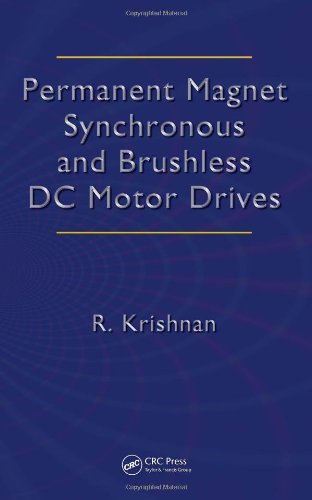Permanent Magnet Synchronous and Brushless DC Motor Drives book download
Par lawing william le mercredi, juillet 6 2016, 04:26 - Lien permanent
Permanent Magnet Synchronous and Brushless DC Motor Drives. Ramu Krishnan

Permanent.Magnet.Synchronous.and.Brushless.DC.Motor.Drives.pdf
ISBN: 0824753844,9780824753849 | 588 pages | 15 Mb

Permanent Magnet Synchronous and Brushless DC Motor Drives Ramu Krishnan
Publisher: CRC
International Conference on Power Engineering, Energy and. The motor in direct drive machines is typically a permanent magnet synchronous motor (brushless DC motor) versus an induction motor. Brushless DC motors are synchronous motors suitable for use as a simple means of controlling permanent drives (e.g. The question is whether BLDC can be classified as an AC or a DC motor. The motor drive simulator includes the DC voltage source, the inverter bridge, and the motor. A synchronous machine with permanent magnets on the rotor is the heart of the modern brushless servomotor drive, often called brushless DC servomotor. Brushless DC motors are also known as Magnet Synchronous motors. The construction of modern brushless motors is very similar to the ac motor, known as the permanent magnet synchronous motor. International Conference on Power Engineering, Energy and Electrical Drives Permanent Magnet Synchronous and Brushless DC Motor Drives. 4 Torque motors; 5 Stepper motors; 6 Permanent magnet motor; 7 Brushless DC motors; 8 Coreless DC motors; 9 Linear motors; 10 Doubly-fed electric motor; 11 Singly-fed electric motor; 12 Dual mechanical port motor; 13 Nanotube nanomotor; 14 Motor starters. The following figure shows an HIL testing system. Figure 2: Basic block diagram of permanent magnet motor drives. Midway between ordinary DC motors and stepper motors lies the realm of the brushless DC motor. Very large synchronous motors are capable of tens of thousands of kW in output, for pipeline compressors, wind-tunnel drives and overland converor systems. ABS pumps, EHPS pumps, fuel pumps or cooling fans). The brushless servomotor lacks the commutator of the DC motor, and has a device ( the drive, sometimes referred to as the amplifier) for making the current flow accord-ing to the rotor position. In the dc motor, increasing the number of commutator seg-ments reduces torque variation. The evaluation board directly connects with one or two DC brush/brushless servomotors, AC asynchronous motors, AC permanent-magnet synchronous servomotors or stepper motors to form a digital servo-motion control system.